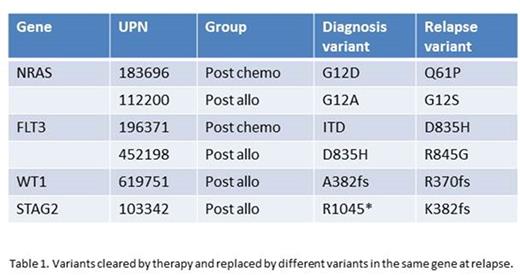Abstract
The evolutionary model of cancer progression suggests that malignant clones survive initial therapy and acquire new mutations, ultimately resulting in therapy-resistant disease. Indeed, previous genomic analyses of AML relapsed after chemotherapy demonstrated clonal evolution, defined as the acquisition of new mutations including new putative driver mutations. Allogeneic hematopoietic stem cell transplant (HSCT) is a potent therapy that provides benefit in part through an immune-mediated Graft-vs-Leukemia (GVL) effect. We and others have hypothesized that the distinctive nature of the therapeutic bottleneck imposed by HSCT may result in distinct patterns of clonal evolution compared to that seen after treatment with chemotherapy alone.
To test this, we performed enhanced exome sequencing of matched diagnosis and relapse tumors to identify somatic mutations in 15 patients who relapsed after matched related or unrelated donor HSCT, including 6 patients with isolated extramedullary relapse. For comparison, we analyzed 20 cases of AML relapsed after chemotherapy alone. In all 35 relapse samples, "new" somatic variants were identified. These were defined as being present in the relapse sample at a variant allele frequency (VAF) >5% and undetectable in the diagnosis sample (no variant reads with at least 40x coverage at that position). Significantly more new variants were observed post HSCT compared with post chemo (new variants post HSCT, 16.8 ±3.5 vs. post chemo, 7.3 ± 1.9, p<.01), an effect that was most striking in the extramedullary relapses (22.0 ± 4.7 new variants). When normalized for time-to-relapse, however, this difference was not significant (new variants per year post HSCT, 9.4 ± 2.1 vs. post chemo, 16.5 ± 7.2, p=NS), suggesting that the rate at which new variants are acquired is not different in relapses after HSCT vs. chemotherapy alone.
At relapse, 13/15 of the post-HSCT cases had acquired previously undetected driver mutations. Of note, there were no mutations that were recurrently associated with relapse after HSCT. In addition, no mutations or copy number changes were observed in MHC genes or in genes involved with antigen presentation, suggesting that these mechanisms may not play a major role in relapse after HSCT. Similarly, no mutations were found that were associated specifically with extramedullary relapse compared to bone marrow relapse. All six extramedullary relapses showed clear evidence of new subclonal populations, and bone marrow biopsies performed at the time of extramedullary relapse showed no evidence of leukemic variants, raising the possibility that extramedullary AML may arise from small numbers of blasts that escape therapy and evolve independently outside the bone marrow.
To assess whether leukemic variants could be detected in remission samples from transplanted patients before relapse, 15-25 leukemic variants were selected from each case and amplicon-based sequencing (providing >2500x coverage on average) was performed on remission samples taken before and after transplant. In 3 of 8 evaluable cases, AML-associated variants were detectable at low levels (i.e. 1 cell in 250) in remission samples obtained after transplant; in two of these patients, multiple variants were detected within 2 months of relapse. In the third patient, a single TET2 mutation was detectable more than 2 years before relapse.
Finally, in 6 relapse cases (4 post HSCT and 2 post chemotherapy) we observed subclones with driver mutations that were cleared after therapy only to be replaced at the time of relapse by a different subclone with a distinct mutation in the same driver gene (Table 1). This suggests that in some cases, relapse may rely upon--and select for--tumor-specific progression events.
In summary, our findings suggest that the clonal evolution of AML relapsing after HSCT is similar to that of AML relapsing after chemotherapy alone. No evidence was found for mutations specifically affecting immune recognition, although the possibility remains that epigenetic changes or host factors may influence the GvL effect after HSCT. Evolutionary complexity is a hallmark of AML, and may play a key role in its propensity for relapse despite the treatment modality used.
No relevant conflicts of interest to declare.
Author notes
Asterisk with author names denotes non-ASH members.


This feature is available to Subscribers Only
Sign In or Create an Account Close Modal